List of Authors
>>About this blog
Recent blog post
|
[Nojinya]
March 22, 2017 09:00
On the way home from work on Friday evening, I decided to drink in Ginza at the invitation of a friend. Expectations are growing for the invitation email saying "It's a little hideaway shop!" The place is Ginza 7-chome along Corridor Street. It's a street I've walked many times before, but I'm always caught by a long queue (Midori Sushi) opposite, and it's a completely no mark, just a hideaway!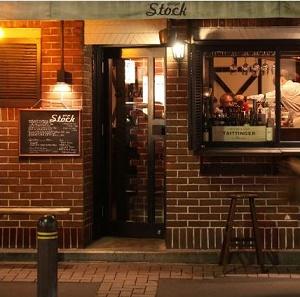
As you can see, the exterior is made of brick and blends completely into the surrounding buildings, but when you open the door one step and enter inside, Risa of the sommelier greets you with a smile in a bright shop.
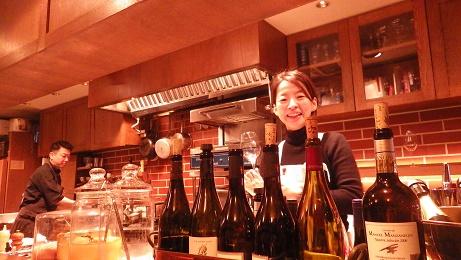 It was just opened (opened at 18:00), so there was only one customer, but a friend says that it is a popular shop where you can not easily get a seat unless you make a reservation in advance with Chan. I enjoy Risa's recommended southern French red wine while eating tidbits putty. In the meantime, new customers came in more and more, and the small store (capacity: 17 people) quickly became full. It was just opened (opened at 18:00), so there was only one customer, but a friend says that it is a popular shop where you can not easily get a seat unless you make a reservation in advance with Chan. I enjoy Risa's recommended southern French red wine while eating tidbits putty. In the meantime, new customers came in more and more, and the small store (capacity: 17 people) quickly became full.
。
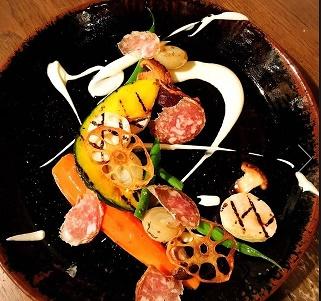
[Seasonal vegetable dish] You can enjoy it with your five senses!
In addition to Southern European wines, dishes that make use of domestic ingredients are also delicious, and they are especially focusing on dishes using Kochi vegetables and fish from Risa.
。
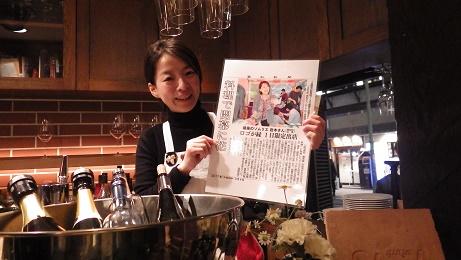
[Risa, who talks about the charm of Kochi with the Kochi Shimbun-sha] "Ginza Sommelier Iwamoto-san (from Kochi City) Cooking Flowers Opening" (March 4, 2005, Kochi Shimbun-sha evening edition)
By the way, Kochi Prefecture is a prefecture that focuses on sightseeing that became famous in the movie "Prefectural Office Hospitality Division (starring Ryo Nishikido and Maki Horikita)" released four years ago!
Risa, who has been appointed as a Kochi Prefecture Tourism Special Envoy in Kochi Prefecture, said, "For two years from March, the Shikoku Kochi late Tokugawa shogunate Restoration Expo has been held to commemorate the 150th anniversary of the reign of the Great Government and the Meiji Restoration, so please go to Kochi! " It is a fun shop where you can enjoy drinking, cooking, talk with Risa and three beats.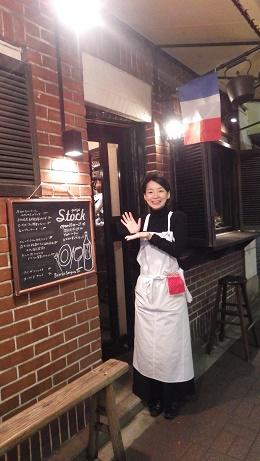
[Bisto Ginza Stock]
Location 7-2-4 Ginza, Chuo-ku, 104-0061, Japan (26th Paul Star Building)
Phone: 03-3572-0201
Business hours 18:00-25:00 (Food LO 23:00 Saturdays, Sundays, and holidays)
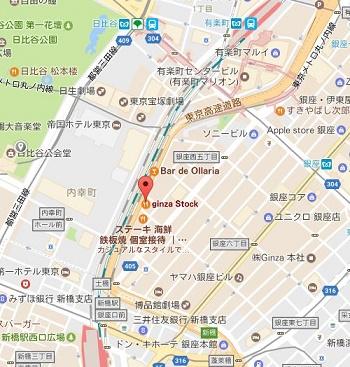
[Nojinya]
February 28, 2017 14:00
Chuo-ku, which has been developed as a cultural and economic center since the Edo period, has various historical sites, including nationally designated important cultural properties. Chuo-ku has been developed mainly as a commercial area, but this time I would like to visit historical sites related to industry. Since the Meiji Industrial Revolution Heritage of Japan was registered in World Heritage in 2015, it has become widely known that industrial facilities are also registered in World Heritage, but in foreign countries (Austria, India, Spain, etc.), active railways and bridges have been registered in World Heritage. In Chuo-ku, there are Eitai Bridge, which is recognized as a civil engineering heritage, and Kachidokibashi, which boasts the uniqueness as the best movable bridge in the East, but this bridge, Harumi Iron Bridge.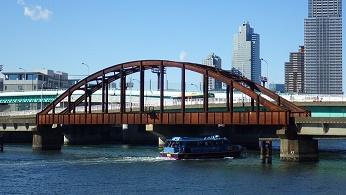
From Triton Square in Harumi, take Harumi-dori St. toward the Toyosu district and cross the Harumi Bridge over the Harumi Canal. The Harumi Railway Bridge is hanging to the south side of the Harumi Bridge. In contrast to the new Harumi Bridge and the high-rise condominiums of Toyosu, rusted arches and concrete bridges show impact, but this is made in 1957 as the Harumi Line of the Port and Harumi Line of the Tokyo Metropolitan Government in 1957, and is linked to the Japanese National Railways via the harbor railway network.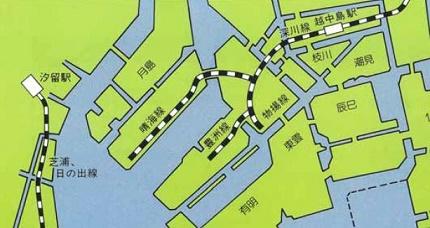
[Tokyo Freight Railway Line Network Map] Provided by Tokyo Port and Harbor Promotion Association, Tokyo Minatokan
The Toyosu area, which had already been redeveloped earlier, was originally a shipyard of Ishikawajima Harima Heavy Industries (IHI), but in the Harumi 2-chome area on the opposite bank, the original dedicated lines, sheds and cement factories were gradually removed, and now it is being reborn as a high-rise apartment, Harumi Rinkai Park, etc.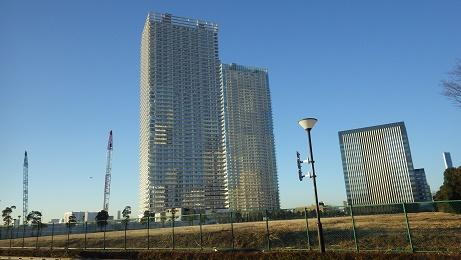
In the first year of 1989 (1989), the Harbor Bureau Harumi Line closed a history of only 32 years due to the conversion of freight transportation to trucks, but the Harumi Railway Bridge still remains due to the cost of removal. I am.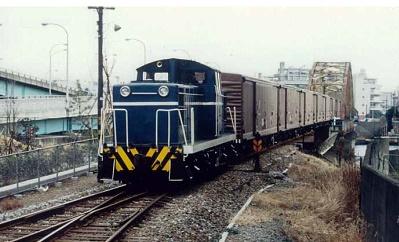
[Tokyo Freight Railway Harumi Railway Bridge] Provided by Tokyo Port and Harbor Promotion Association, Tokyo Minatokan
Of course, this bridge is not used at present because the freight line has been abolished, but from a global perspective, there are many cases where such a historic bridge has been reborn as a tourist attraction, along with the adjacent Harumi Park, It is a historic site that symbolizes the capital city of Chuo-ku and wants to keep it as a heritage that tells the history of Harumi Wharf. At the site of the Ishikawajima Shipyard in Toyosu on the opposite bank, the original shipbuilding crane is lit up in LaLaport, a commercial facility built on the site, making it a tourist attraction (the situation can be seen from Chuo-ku). ). Many cultural properties currently registered in World Heritage have revived their potential value through local efforts, such as the ruins of St Paul Temple in Macao and the Sitho monastery in France.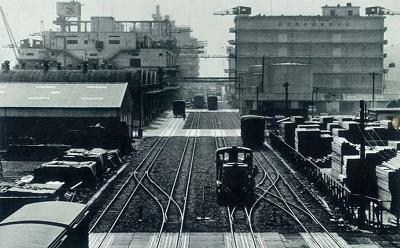
[Tokyo Freight Railway Harumi Wharf Station] Provided by Tokyo Port and Harbor Promotion Association, Tokyo Minatokan
The photo below shows Harumi Ohashi, which was taken from the boat at the museum. It was a thrilling cruise that passed through the bottom of the girder.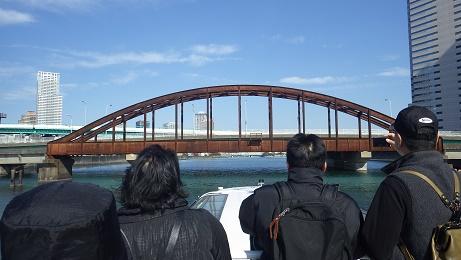
[Harumi Railway Bridge]
〒104-0053 Harumi Bridge Nishizume 2-chome Harumi Bridge, Chuo-ku (Northest station: a 15-minute walk from Tsukishima Station on the Yurakucho Line and Oedo Line).
[Nojinya]
January 31, 2017 14:00
There are many bridges in Chuo-ku, a waterside town. In particular, the Sumida River, which flows through the border with Koto-ku, has many unique bridges, including the 8 bridges of the Sumida River, which was also selected as one of the 18 Views of Ohako (selected by Chuo-ku Tourism Association in 2007). . Eitai Bridge, Chuo-ohashi Bridge and Kachidokibashi, which are often introduced on correspondent blogs, are very popular, and you can immediately see where and shape are, but this time it is somewhat less famous compared to such a star-class bridge I will introduce "Aioi Bridge".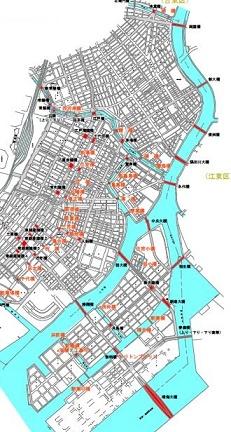
The Sumida River, which flows from the direction of Senju and Asakusa, crosses the Eitai Bridge and hits Okawabata on Tsukuda Island, where it is divided into the main stream of the Sumida River passing through Chuo-ohashi Bridge and the Sumida River school river heading to the left. You. Aioi Bridge is a bridge that spans the faction river that flows to the left. Tsukishima and Tsukuda (island) are now connected to Tsukiji and Fukagawa areas (Koto-ku) by many bridges and subways, but at the time Tsukishima was built in 1892, as the name suggests, this is the Sumida River Nakashu, and access was only ferry (Tsukuda, Tsukishima). Therefore, in 1903, Aioi Bridge was built as the first bridge connecting Fukagawa (Ecchujima) and Tsukuda / Tsukishima districts. 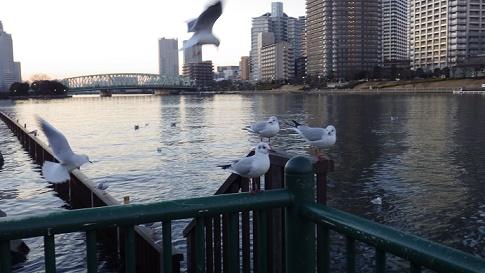 The name of Aioi Bridge is "The bridge relative to the upstream Eitai Bridge (Tokyo Metropolitan Bureau of Construction)" and "This bridge was a long and short bridge at the time of its founding, and is derived from two sets of "Aioi no Matsu" (wikipedia) ) ". Aioi Bridge consisted of two bridges (Aioi Ohashi: 147m, Aioi Kobashi: 53m) along Nakanoshima (Nakashu) floating in the school river. In 1980, the lower part of Aioi Kobashi (currently around the razor dike along Kiyosumi-dori) was reclaimed. Although it is connected to land, Nakanoshima still remains as a circular park with trees under Aioi Bridge Higashizume, and you can descend with stairs beside Kiyosumi-dori of the bridge. If you descend from the entrance on the upstream side (north side), there is a passage along the river, and you can go under the bridge to the other side. The name of Aioi Bridge is "The bridge relative to the upstream Eitai Bridge (Tokyo Metropolitan Bureau of Construction)" and "This bridge was a long and short bridge at the time of its founding, and is derived from two sets of "Aioi no Matsu" (wikipedia) ) ". Aioi Bridge consisted of two bridges (Aioi Ohashi: 147m, Aioi Kobashi: 53m) along Nakanoshima (Nakashu) floating in the school river. In 1980, the lower part of Aioi Kobashi (currently around the razor dike along Kiyosumi-dori) was reclaimed. Although it is connected to land, Nakanoshima still remains as a circular park with trees under Aioi Bridge Higashizume, and you can descend with stairs beside Kiyosumi-dori of the bridge. If you descend from the entrance on the upstream side (north side), there is a passage along the river, and you can go under the bridge to the other side. 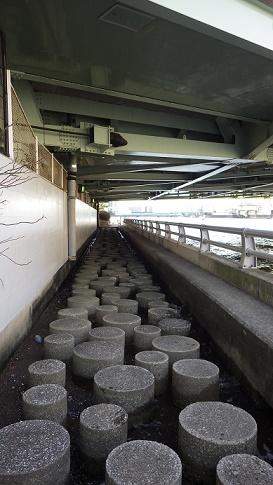 There are many parts of the Sumida River Terrace where proper sidewalks are maintained, but here you can feel like an adventure just because there are round stone pillars lined up. Going downstream (south side), it is a continuation of the park centered on lantern monuments. There are many parts of the Sumida River Terrace where proper sidewalks are maintained, but here you can feel like an adventure just because there are round stone pillars lined up. Going downstream (south side), it is a continuation of the park centered on lantern monuments.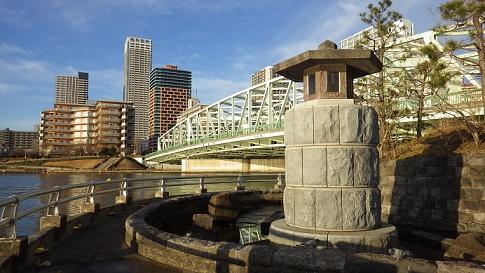
On the left is the Meiji Maru of Marine University, Toyosu Tower Condominiums and Harumi Bridge in front, and on the right you can see the whole view of Aioi Bridge. Aioi Bridge has a slightly sober impression compared to Eitai Bridge and Chuo-ohashi Bridge, which are lit up at night, but as shown in the photo, it is a bridge with a complicated truss structure that connects steel frames to "N" (or "X") characters. Of course, it is a beautiful bridge even at night, but its beauty seems to shine when it is lit by the sun. Although it is Koto-ku next door, Nakanoshima Park and Meiji Maru are said to have been selected as Koto Hakkei.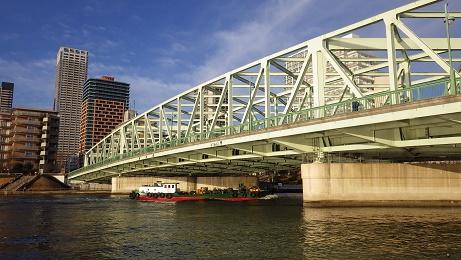
Nakanoshima Park has long been known as a famous spot for viewing the moon, but as you can see, it has a structure where the water of the Sumida River enters inside. Especially on the full moon night, tide level is high, and after high tide or a large ship passes, the water comes in by the wave, so be careful and enjoy it.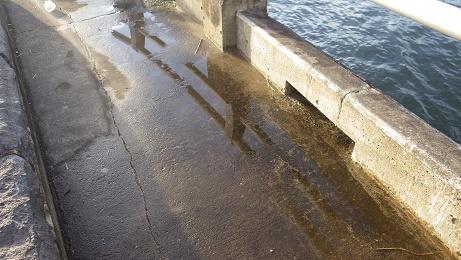
The Aioi Bridge itself is a bit plain, but the scenery seen from the bridge is superb. You can enjoy a wonderful night view such as a monument to light up the tower apartment in the Toyosu area and the Dock in Urban Dock LaLaport and Toyosu, as well as an airplane taking off from Haneda Airport to Tohoku and Hokkaido, and a new transportation Yurikamome running on Toyosu. You.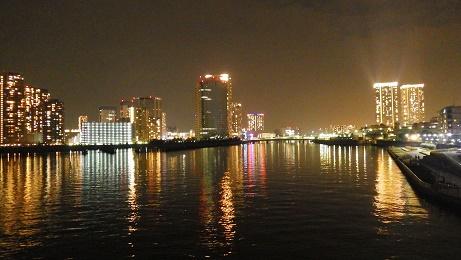
[Aioi Bridge]
Location :2-20 Tsukuda, Chuo-ku, 104-0051, Japan
(5-minute walk from Tsukishima on the Oedo Line and Yurakucho Line)
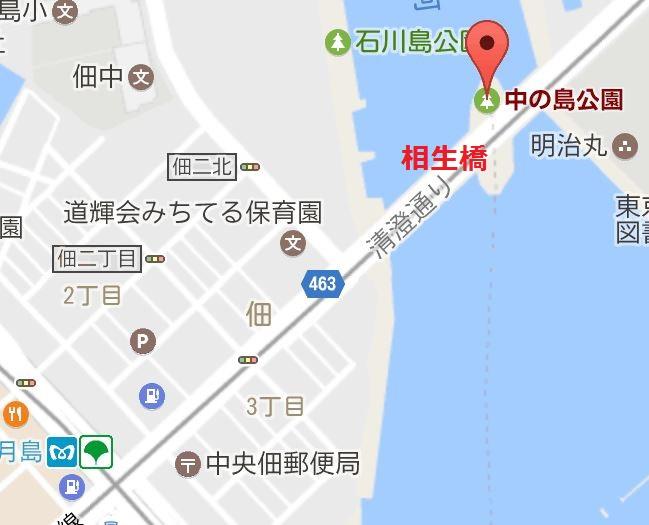
[Nojinya]
December 1, 2016 12:00
On October 30, the number of foreign tourists visiting Japan (inbound tourists) reached 20.05 million (announced by JNTO), surpassing 20 million for the first time. The government doubled the target number of inbound customers in March this year to 40 million by 2020, but it has become extremely common to see foreigners in Chuo-ku. On the other hand, a local friend who moved to Tokyo said, "I can't get a hotel, what should I do! 。 。 。 There are vacancies, but it's expensive and I can't stay at the company's prescribed travel expenses." I often go to Kansai and Hokkaido, which are popular among foreign visitors to Japan on business trips, but I certainly feel that it has become difficult to make reservations for hotels that have been set up recently.
I wonder if this is the case. It seems that the number of shared room-style accommodations with many beds in some rooms such as guest houses, mainly in sightseeing spots, has recently increased. How about in Tokyo? 。 。 。 When I searched, it seems that there are many guesthouses in areas such as Asakusa, Minami-Senju, Shinjuku, etc., but in Chuo-ku, where business passenger demand is strong, there are many business hotels such as Toyoko Inn, Super Hotel, and Apa Hotel, but I never heard much about guesthouses.
A while ago, the story of Toyomi Bridge and the novel "Onjuku Kasemi" ("Chuo-ku (Part 5)-Onjuku Kasemi-~ (/archive / 2016/11/post-3819.html) "), But on a sunny Sunday morning, across the Toyomi Bridge and across the Nihonbashi Bridge Name of Nihonbashi River. 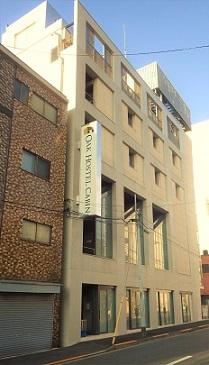 When you climb the stairs and open the door on the second floor, you will receive a reception. When I heard the story, it was still a guest house. As it opened in March 2015, I should have passed in front of me many times, but I didn't notice it because it was night and the appearance was like a normal office building. It seems that there was no introduction on the Chuo-ku Tourism Association blog yet, so I was in the middle of a walk, but decided to cover it. When you climb the stairs and open the door on the second floor, you will receive a reception. When I heard the story, it was still a guest house. As it opened in March 2015, I should have passed in front of me many times, but I didn't notice it because it was night and the appearance was like a normal office building. It seems that there was no introduction on the Chuo-ku Tourism Association blog yet, so I was in the middle of a walk, but decided to cover it.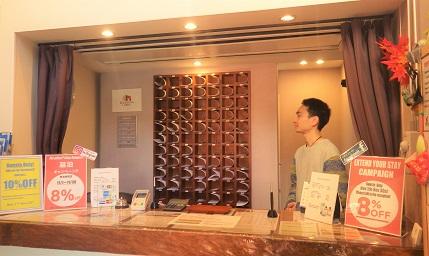
Take off your shoes in front of the reception on the second floor and put them in a shoe locker beside it. Because it is locked, there is no mistake or loss of shoes that tend to be a large inn, so it is safe. The back of the reception is a shared lounge, which seems to be comfortable with the bright sunlight in the morning. There is also a kitchen that can be used freely by guests in the lounge, and at night it will be lively with a drinking party for exchanging information on a trip! 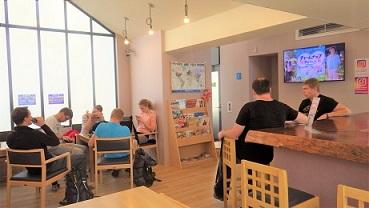 The 1st, 3rd and 4th floors of a 5-story building are accommodation floors, with 86 cells (private rooms) as in the capsule hotel. There is no large public bath because it is an economy hotel, but you can sweat your trip in the shower room on the 5th floor (9 rooms)! The 1st, 3rd and 4th floors of a 5-story building are accommodation floors, with 86 cells (private rooms) as in the capsule hotel. There is no large public bath because it is an economy hotel, but you can sweat your trip in the shower room on the 5th floor (9 rooms)! 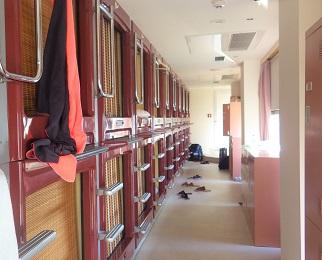 In addition, there are washing machines and dryers (paid), as well as rentals of towels and yukata (paid). There seems to be a rental bicycle (600 yen a day), so I would like foreigners who are staying to visit the famous places in Chuo-ku by all means. In addition, there are washing machines and dryers (paid), as well as rentals of towels and yukata (paid). There seems to be a rental bicycle (600 yen a day), so I would like foreigners who are staying to visit the famous places in Chuo-ku by all means. 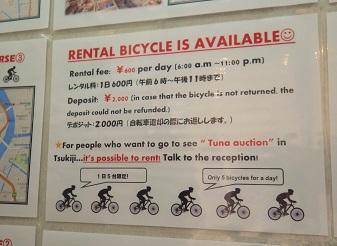 In the novel, Onjuku Kasemi was an inn where people could stay with peace of mind due to the thick humanity of the people surrounding the master's Rukasemi, but in the inbound era Kasemi "Oak Hostel Cabin" seems to be a cozy stay. In the novel, Onjuku Kasemi was an inn where people could stay with peace of mind due to the thick humanity of the people surrounding the master's Rukasemi, but in the inbound era Kasemi "Oak Hostel Cabin" seems to be a cozy stay.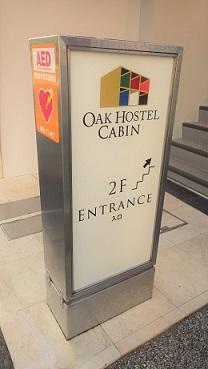
[Oak Hostel Cabin]
Location 1-16, Nihonbashi-Hakozakicho, Chuo-ku, 103-0015, Japan
Phone: 03-6264-9452
Accommodation fee: ¥2,500/ Name ~ (depending on the day)
Access It is about a 7-minute walk from Kayabacho Subway Station, Suitengu Station, and TCAT.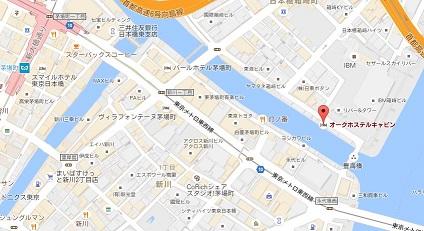
[Nojinya]
Nov. 26, 2016 16:00
Hello! What do you think of when you hear "Kiha"? 。 。 。 The person who immediately answered, "It's a diesel car!" 。 。 It's a good answer!
When I hear "Kiha", I remember Jiro Asada's short novel "Poppiya (Shueisha Bunko)".
"When you leave the platform at Miyoro Station, Horomai's single line runs alongside the main line for a while before passing through the streets. The glass-walled resort limited express passes through the Kiha 12-type railcar slowly as if you were looking at it. Whether it's a mischief of the diamond or a production prepared for the urban skier, the train windows of the limited express are bells, watching the vermilion Japan National Railways. 。 。 <Omitted>. 。 。 Kiha 12, which departs at 18:35, is the last of Horomai, which runs only three times a day. "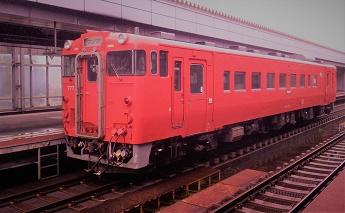
[Nemuro Main Line Kiha 40 bound for Takigawa, which is stopped at Obihiro Station]
"Railroad worker" is a story that develops as the main character of the local line station manager Otomatsu Sato (Ken Takakura), just before the abandoned line in Hokkaido. It was made into a movie in 1999, but at that time, location was being performed at Ikutora Station on the Nemuro Main Line in Minamifurano-cho (Note: Nemuro Main Line was typhoon No. 10 on August 30, this year. It is said that restoration is difficult due to the damage caused by the damage, partly due to the business situation of JR Hokkaido). In commemoration of the movie adaptation, Ikutora Station preserves the top part of Kiha 12, which was modified from Kiha 40. preserves the top part of Kiha 12, which was modified from Kiha 40.
Here is a mini commentary, "Kiha" is a type symbol of JR vehicles. "Ki" refers to a diesel car (railcar) as it is, and "C" refers to an ordinary car, and "Kiha" refers to an ordinary car of a diesel car. Some of the similar ones are "Moha", but "Mo" is a train vehicle (electric vehicle) with a motor and refers to a regular train car. Instead of "c", "c", "shi" or "ne" may enter, but "kilo" is a green car of a diesel car, a dining car if "shi" is entered to a diesel car (railcar) as it is, and "C" refers to an ordinary car, and "Kiha" refers to an ordinary car of a diesel car. Some of the similar ones are "Moha", but "Mo" is a train vehicle (electric vehicle) with a motor and refers to a regular train car. Instead of "c", "c", "shi" or "ne" may enter, but "kilo" is a green car of a diesel car, a dining car if "shi" is entered , and "ne" is a sleeping car . , and "ne" is a sleeping car .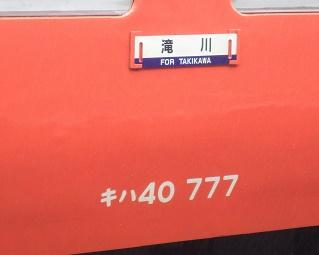
。 。 。 The preface has become longer, but it's time to go to the main subject.
This time, I was a boy who was a railway kid, and a friend with a strong iron told me, "Let's go for drinking !" After work, join at Ningyocho Station and walk for about 5 minutes in the direction of Horidome-cho, where the success Inari is located. Then, in the dark, you will see a common "Noriba" guide at the station. !" After work, join at Ningyocho Station and walk for about 5 minutes in the direction of Horidome-cho, where the success Inari is located. Then, in the dark, you will see a common "Noriba" guide at the station.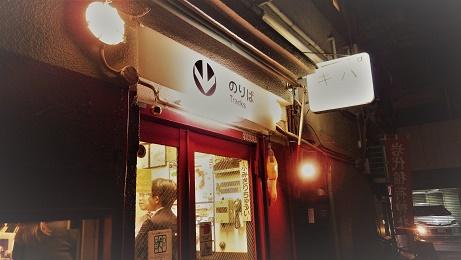
When you open the door unintentionally and enter inside, you will receive a voice of an assistant (master) saying "Thank you for your ride!" There is a yellow information board on the left of the entrance, which is like a subway station yard exit, a transfer to the Hibiya Line, Asakusa Line 2 (although it is actually on the second floor). If you go to the back of the store, you will find a buffet car on the limited express train (Is it a "Kiha" cafeteria car?) A few customers are already enjoying beer  and cooking at the counter like in the above. On the counter, canned food of this store is piled up high, and when ordered by an assistant, it cooks one by one and serves as a snack. First of all, while drinking a toast beer and cooking at the counter like in the above. On the counter, canned food of this store is piled up high, and when ordered by an assistant, it cooks one by one and serves as a snack. First of all, while drinking a toast beer , I decided to have an oil serdin selected by a friend. , I decided to have an oil serdin selected by a friend. 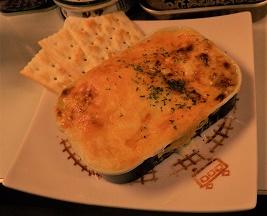 It's quite delicious It's quite delicious because it's stupid with canned food! 。 。 。 And the second cup is a one-cup liquor because it's stupid with canned food! 。 。 。 And the second cup is a one-cup liquor that is indispensable for railway trips. The locally brewed sake Cup in Niigata (Gosen City), where the picture of SL (C57) is drawn! that is indispensable for railway trips. The locally brewed sake Cup in Niigata (Gosen City), where the picture of SL (C57) is drawn! 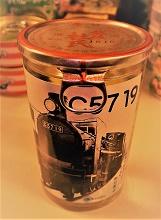 When drinking while saying "It's delicious" with a friend, the customer who was in the back is the manufacturer of the One Cup sake (Kinshihai Sake Brewery) http://www.kinshihai.com/index.html) ) With the president. Today, he was on a business trip to Tokyo, and he stopped by this shop that wholesales sake and also served as a greeting. I feel like traveling with unexpected encounters! When drinking while saying "It's delicious" with a friend, the customer who was in the back is the manufacturer of the One Cup sake (Kinshihai Sake Brewery) http://www.kinshihai.com/index.html) ) With the president. Today, he was on a business trip to Tokyo, and he stopped by this shop that wholesales sake and also served as a greeting. I feel like traveling with unexpected encounters!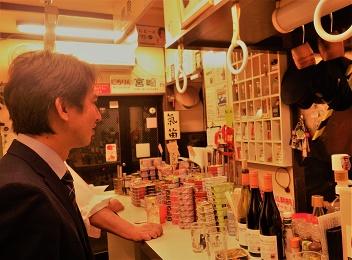
There is a strap that can be grabbed on the counter even if you get drunk, and on the second floor you can sit on a long train seat and drink. It was a standing drink, so I wanted to go in a little bit, but after all, I stayed for about two and a half hours in the delicious food, alcohol, and the fun atmosphere of the shop.
[Kiha, the last station for alcohol and railway lovers]
Location 1-6-11, Nihonbashi-Horidomecho, Chuo-ku, 103-0012, Japan
Phone: 03‐5651‐5088
Business hours From 18:00 to 23:30 (Open on Sundays and holidays, irregular operation (open) on Saturday, so check in advance)
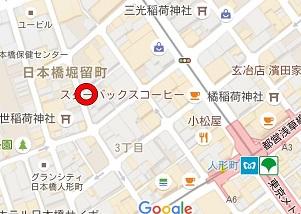
[Nojinya]
Nov. 25, 2016 14:00
Large and long-lasting shaking at dawn (November 22). 。 。 It's been a big earthquake since a long time. Fortunately, there seems to be no direct human damage related to life and death so far, but it was a morning when I was reminded of Japan, a country with many disasters (earthquakes, tsunamis, typhoons, etc.).
For Japan, where the number of foreign tourists is rapidly increasing, it is of course important to introduce content such as history and culture, but also to provide information on disaster preparedness and safety in Japan, especially earthquakes and typhoons. It is also important to give a sufficient explanation of the safety in Japan to inbound tourists who are unfamiliar with disasters, and to have them visit with peace of mind in the future.
It seems that the earthquake has subsided, so when I cross Minami Takahashi near my house for work, the sluice gate from the Kamejima River, which should normally open, to the Sumida River, is closed on a street such as the Nihonbashi Cruise. Is it prepared for the tsunami? (The Japan Meteorological Agency sent tsunami advisory to Uchibo and Izu Islands in Chiba Prefecture at 7:26 am.)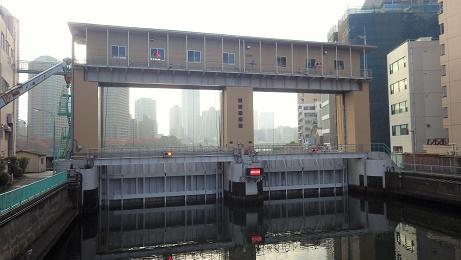
The Kamejima River Sluice Gate is a tide gate created to protect the Kamejima River basin from storm surge damage. The downtown area of Tokyo, which has developed by reclaiming the Hibiya cove since the Edo period, has long been a lot of storm surges and tsunamis. I've been suffering from flood damage. Chuo-ku is also located in areas with relatively low ground heights, and is no exception in this case.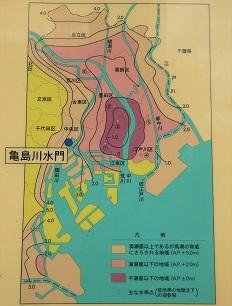
For example, there is a story called "Tsunami" in Seicho Matsumoto's short story book "Mujukujinbetsu Book" (Bunshun Bunko), which was introduced in a blog post I wrote earlier (/archive / 2014/06/post-2075.html), but here, a tsunami depicts a people's footing in Ishikawajima during the Edo period. After the Meiji era, coastal areas such as the Sumida River in the eastern lowland of Tokyo became flooded areas such as floods and storm surges, and storm surge countermeasures were promoted after severe damage such as the Kitty Typhoon (1949) that hit the Kanto area. Will be
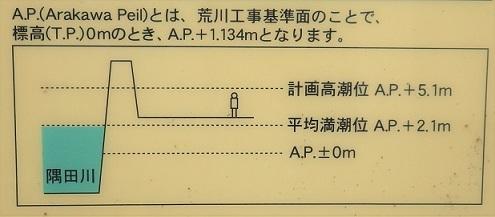
In particular, the storm surge of A.P. + 5.02m in the Nagoya area due to the typhoon in Ise Bay in 1960 (A.P. is "Arakawa Construction Standard Surface". It is determined at the lowest water level of water level station, Reigishi Island in Shinkawa. See the figure above. In the 1960s, the construction of seawalls, the so-called razor dike, began in Tokyo. The Kamejima River Sluice Gate was also completed in 1969 at this time. The gate of the sluice gate is 8.3m, which can prevent storm surges from entering the Kamejima River as well as seawalls. As a result of these measures, when Typhoon No. 20 hit in October 1979, a storm surge (A.P + 3.55m) exceeding the Kitty Typhoon was recorded, but the lives of the local residents were protected without breaching.
It was a Kamejima River sluice gate that I rarely see, but as in this case, when a tsunami or storm surge occurred due to an earthquake or typhoon, etc. and the water level of the river rises, the sluice was closed as soon as possible to prevent flooding and protect the safety of residents and visitors to Chuo-ku. .
[Kamejima River Sluice Gate]
Location 2-31-22 Shinkawa, Chuo-ku, 104-0033, Japan
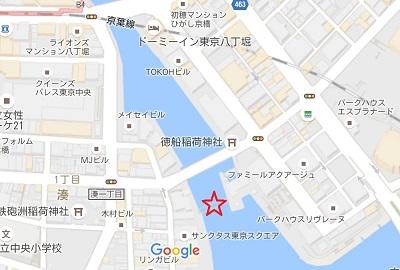
|
Links
|

 It was just opened (opened at 18:00), so there was only one customer, but a friend says that it is a popular shop where you can not easily get a seat unless you make a reservation in advance with Chan. I enjoy Risa's recommended southern French red wine while eating tidbits putty. In the meantime, new customers came in more and more, and the small store (capacity: 17 people) quickly became full.
It was just opened (opened at 18:00), so there was only one customer, but a friend says that it is a popular shop where you can not easily get a seat unless you make a reservation in advance with Chan. I enjoy Risa's recommended southern French red wine while eating tidbits putty. In the meantime, new customers came in more and more, and the small store (capacity: 17 people) quickly became full.










 The name of Aioi Bridge is "The bridge relative to the upstream Eitai Bridge (Tokyo Metropolitan Bureau of Construction)" and "This bridge was a long and short bridge at the time of its founding, and is derived from two sets of "Aioi no Matsu" (wikipedia) ) ". Aioi Bridge consisted of two bridges (Aioi Ohashi: 147m, Aioi Kobashi: 53m) along Nakanoshima (Nakashu) floating in the school river. In 1980, the lower part of Aioi Kobashi (currently around the razor dike along Kiyosumi-dori) was reclaimed. Although it is connected to land, Nakanoshima still remains as a circular park with trees under Aioi Bridge Higashizume, and you can descend with stairs beside Kiyosumi-dori of the bridge. If you descend from the entrance on the upstream side (north side), there is a passage along the river, and you can go under the bridge to the other side.
The name of Aioi Bridge is "The bridge relative to the upstream Eitai Bridge (Tokyo Metropolitan Bureau of Construction)" and "This bridge was a long and short bridge at the time of its founding, and is derived from two sets of "Aioi no Matsu" (wikipedia) ) ". Aioi Bridge consisted of two bridges (Aioi Ohashi: 147m, Aioi Kobashi: 53m) along Nakanoshima (Nakashu) floating in the school river. In 1980, the lower part of Aioi Kobashi (currently around the razor dike along Kiyosumi-dori) was reclaimed. Although it is connected to land, Nakanoshima still remains as a circular park with trees under Aioi Bridge Higashizume, and you can descend with stairs beside Kiyosumi-dori of the bridge. If you descend from the entrance on the upstream side (north side), there is a passage along the river, and you can go under the bridge to the other side.  There are many parts of the Sumida River Terrace where proper sidewalks are maintained, but here you can feel like an adventure just because there are round stone pillars lined up. Going downstream (south side), it is a continuation of the park centered on lantern monuments.
There are many parts of the Sumida River Terrace where proper sidewalks are maintained, but here you can feel like an adventure just because there are round stone pillars lined up. Going downstream (south side), it is a continuation of the park centered on lantern monuments.




 When you climb the stairs and open the door on the second floor, you will receive a reception. When I heard the story, it was still a guest house. As it opened in March 2015, I should have passed in front of me many times, but I didn't notice it because it was night and the appearance was like a normal office building. It seems that there was no introduction on the Chuo-ku Tourism Association blog yet, so I was in the middle of a walk, but decided to cover it.
When you climb the stairs and open the door on the second floor, you will receive a reception. When I heard the story, it was still a guest house. As it opened in March 2015, I should have passed in front of me many times, but I didn't notice it because it was night and the appearance was like a normal office building. It seems that there was no introduction on the Chuo-ku Tourism Association blog yet, so I was in the middle of a walk, but decided to cover it.
 The 1st, 3rd and 4th floors of a 5-story building are accommodation floors, with 86 cells (private rooms) as in the capsule hotel. There is no large public bath because it is an economy hotel, but you can sweat your trip in the shower room on the 5th floor (9 rooms)!
The 1st, 3rd and 4th floors of a 5-story building are accommodation floors, with 86 cells (private rooms) as in the capsule hotel. There is no large public bath because it is an economy hotel, but you can sweat your trip in the shower room on the 5th floor (9 rooms)!  In addition, there are washing machines and dryers (paid), as well as rentals of towels and yukata (paid). There seems to be a rental bicycle (600 yen a day), so I would like foreigners who are staying to visit the famous places in Chuo-ku by all means.
In addition, there are washing machines and dryers (paid), as well as rentals of towels and yukata (paid). There seems to be a rental bicycle (600 yen a day), so I would like foreigners who are staying to visit the famous places in Chuo-ku by all means.  In the novel, Onjuku Kasemi was an inn where people could stay with peace of mind due to the thick humanity of the people surrounding the master's Rukasemi, but in the inbound era Kasemi "Oak Hostel Cabin" seems to be a cozy stay.
In the novel, Onjuku Kasemi was an inn where people could stay with peace of mind due to the thick humanity of the people surrounding the master's Rukasemi, but in the inbound era Kasemi "Oak Hostel Cabin" seems to be a cozy stay.




 It's quite delicious
It's quite delicious When drinking while saying "It's delicious" with a friend, the customer who was in the back is the manufacturer of the One Cup sake (Kinshihai Sake Brewery)
When drinking while saying "It's delicious" with a friend, the customer who was in the back is the manufacturer of the One Cup sake (Kinshihai Sake Brewery) 





